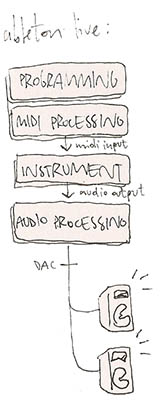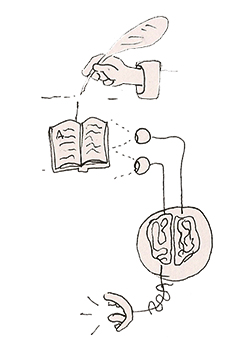The project I’m starting now is actually something I’ve been working on for a few months, and which I think fits the SoP brief quite well. For this reason I have decided to present it as a uni work. What I am working on now is so to speak a formalisation and presentation of the project’s conceptual framework, in order to fulfill the steps that the brief required me to take before I actually start working on the project’s outcome.
So the object I decided to take as a starting point is Aphex Twin’s EP “Come to Daddy” – not the CD, record or any other form it’s been published in, but the actual music. The space it has been produced in is a bit of a tricky question, because as in all electronic music (and this is especially true for Aphex Twin’s), it is pretty difficult to trace back the gear that was used to compose and produce it. However, I consider this gear to be its space of production, because – again, particularly in electronic music – the instrument(s) on which you compose play a major role in how you conceptualise and understand the product of your composition work.
It’s enough to google “aphex twin gear” to realise that there’s loads of people asking themselves “how he does it”, and he himself tends to dodge the question or give very vague answers. So instead of setting out to reconstruct exactly how Come to Daddy was done, I figured out that I’d settle for a “comparable place” and started sketching out how I understand electronic music to be done:
Also, let’s not forget the actual objects that are used to create this space: in 1997 (Come to Daddy‘s release year) a heap of hardware on one or more tables or racks
and today, although hardware is stilled used by many artists, you can potentially do everything with musical software running on a general computer with a couple of extensions (mostly a MIDI controller and an external audio/MIDI interface).
Also, because the brief requires me to make some drawings if the space I’m working with, and I don’t want these drawings to be only diagrams and flowcharts, I started to think of how I could represent the workflow of making electronic music in terms of objects or at least in a way that would closer to self-explanatory than a bunch of boxes connected with lines, and my first idea was to re-draw the first diagram as a piping system (divided in two bits because it tragically didn’t fit into my sketchbook).
I knew from the beginning that I was going to work with Ableton Live, so thinking of this it struck me that in the Live chain of devices (which I’ll come back to at some point later on) the sequencing bit comes before the instrument – so to speak the other way around than in my diagram.
 As a quick explanation, in case you have no idea what I’m talking about: a sequencer is a device, hardware or software, in which you write the music that the instrument(s), mostly samplers or synthesizer, are going to play. I had previously assumed that the instruments would “send” their sounds to the sequencer that would “play” them, but it seems like in Ableton the instrument plays the score written in the sequencer. I don’t know how relevant this information is, by the way…
As a quick explanation, in case you have no idea what I’m talking about: a sequencer is a device, hardware or software, in which you write the music that the instrument(s), mostly samplers or synthesizer, are going to play. I had previously assumed that the instruments would “send” their sounds to the sequencer that would “play” them, but it seems like in Ableton the instrument plays the score written in the sequencer. I don’t know how relevant this information is, by the way…
However, I’ve been thinking about how to explain all this stuff in a visual way and make these drawings out of it… I wonder if one by-product of my project will be a sort of general introduction to electronic music?





